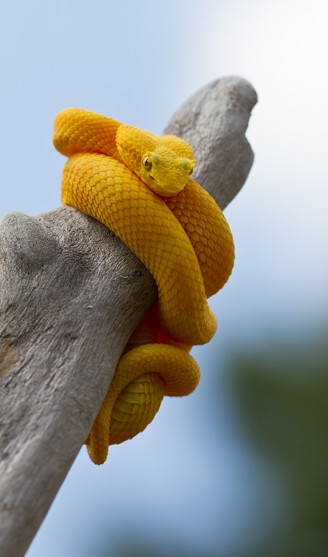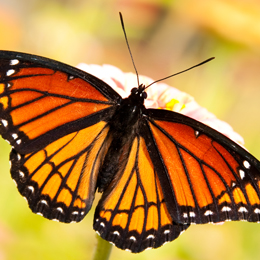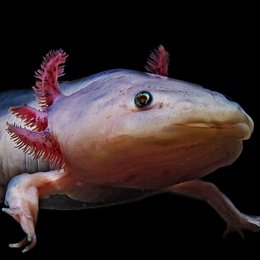Description
Also known as the ‘horned palm viper’ or ‘bocaraca’, the eyelash viper gets its name due to a unique set of scales over its eyes that resemble 'eyelashes'. Very less is known about the purpose of this feature. Some biologists believe that the eyelashes help the snake in camouflage while it waits patiently for its prey. Even though the eyelash viper exists in many different colors, bright green and yellow eyelash vipers are the most common among them.
Their color mainly depends on their habitat and surroundings. The yellow colored eyelash viper can be found camouflaged in bananas while the green one hides in vegetation. Reddish-brown colored viper uses tree bark or red and brown colored flowers to hide from predators and prey. The colors of a newborn eyelash viper change in time and reaches the final shade when it enters adulthood.
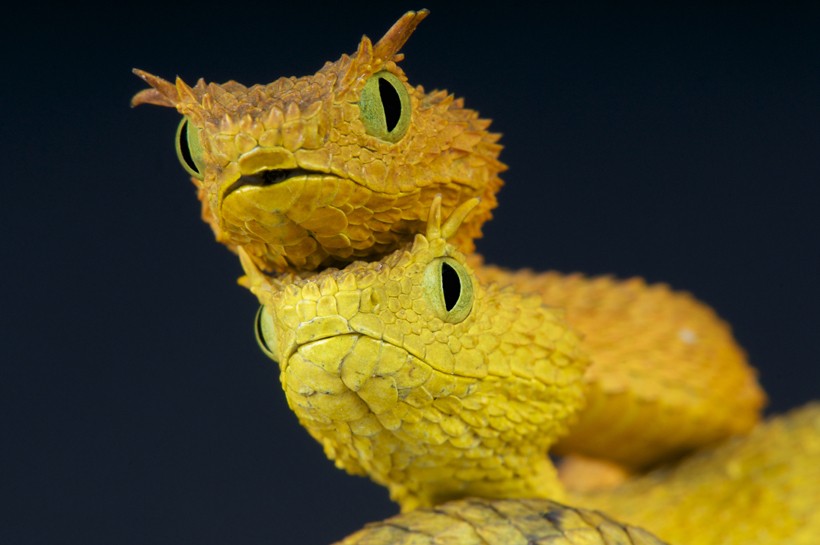
The purpose of the lashes is unknown, though some biologists believe that it helps the snake camouflage.
?
Image credits: reptiles4all/Shutterstock
There are no external features that can differentiate a male eyelash viper from a female one. However, a female eyelash viper tends to grow larger than the males. Like most snakes, this pit viper grows as long as it lives and an adult can reach up to 2 ft in length. It can live for up to 16 years in a captive atmosphere but in the wild, the lifespan decreases to 10-12 years due to predation and sometimes lack of prey and habitat.
The eyelash vipers are smaller and weighs less compared to other pit vipers, due to their arboreal nature. Just like all venomous pit vipers, the eyelash viper snake has a set of well-developed senses that enables it to hunt with precision. The snake has heat-sensitive pits on both sides of its head, along with acute binocular vision and sense of smell. Just like most snakes it also makes use of a unique organ called the Jacobson’s organ, located inside its mouth, to pick up chemical scents and pheromones left in the air by other animals. The snake repeatedly uses its tongue to sense the chemical information available from the surroundings.
Habitat
Eyelash viper is found mainly in tropical rainforests of Central and South America. Like all cold-blooded animals, they cannot regulate their body temperature on their own. They have to depend on their surroundings to maintain a warm inner temperature. Therefore, the tropical climate proves to be ideal for their growth and survival. The eyelash viper dwells close to permanent water sources due to the abundance of prey items and cooler temperatures near fresh water bodies.
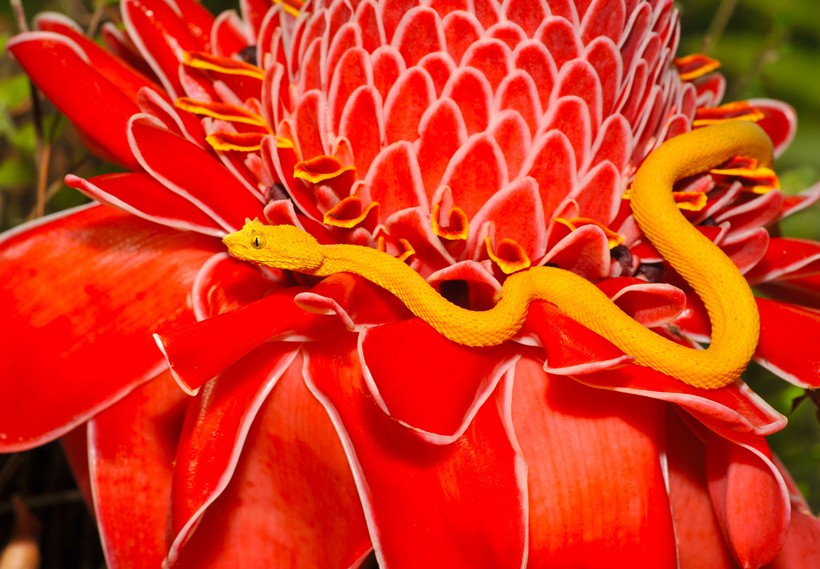
Beautiful yellow viper on a red flower
?
Image credits: worldswildlifewonders/Shutterstock
Eyelash viper is found mainly in tropical rainforests of Central and South America. Like all cold-blooded animals, they cannot regulate their body temperature on their own. They have to depend on their surroundings to maintain a warm inner temperature. Therefore, the tropical climate proves to be ideal for their growth and survival. The eyelash viper dwells close to permanent water sources due to the abundance of prey items and cooler temperatures near fresh water bodies.
The eyelash viper is a very efficient ambush predator and wanders alone. It is a nocturnal creature and hunts most of the night. It lays perfectly camouflaged in its surroundings and can wait for hours for an unsuspecting prey to move closer. As soon as the prey is in striking range, it unleashes a lightning fast attack on the prey and injects lethal hemotoxic venom. Once hit, it patiently waits for its victim to succumb against the effects of the poison and then swallows it in one piece. Eyelash viper preys on small mammals, lizards and small birds. Humming birds often fall prey to this animal; they hover around plants and brightly colored flowers for nectar, unaware of the camouflaged eyelash waiting for its next meal. This snake also uses a method called ‘caudal luring’, to catch its prey. It wiggles the tip of its tail to mimic a worm or a small insect, using it as bait to attract the prey.
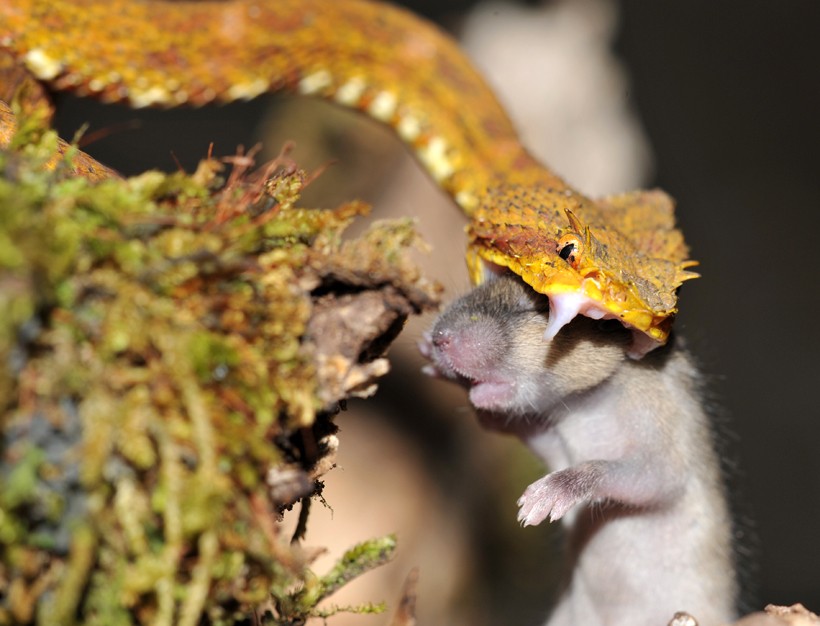
Eyelash viper strikes a mouse
?
Image credits: worldswildlifewonders/Shutterstock
An eyelash viper is a shy creature and often maintains distance from humans. Human fatalities due to eyelash pit viper bite often occur when the snake is disturbed or threatened. It lives in a very challenging atmosphere, where it has to compete consistently with other species for food and survival. Many larger predators feed on small snakes and other reptiles. The deadliest of all eyelash viper predators are raptors, gray foxes and other larger venomous snakes and constrictors. When the snake is not hunting for food, it stays low and uses its colorful scales and camouflaging techniques to blend into the surroundings to stay safe from predators.
Reproduction and Life Cycle
Eyelash viper or Bothriechis schlegelii lives an average lifespan of 12 years and reaches sexual maturity at the age of 2 years. In ideal conditions, they can mate throughout the year. It uses its acute sense of smell and chemical sensing to spot potential mates. However, on its path, an eyelash viper is often confronted with other male vipers in search of females for reproduction. When confronted with another male, the vipers try to intimidate each other by engaging in the “dance of adders”. During this courtship ritual, both males take an upright posture and try to push each other down; the one to fall first loses.
These fights are harmless and the snakes rarely get any injuries as they don’t use their fangs or venom during the ‘dance of adders’. The winner male then moves to his prize, the female.
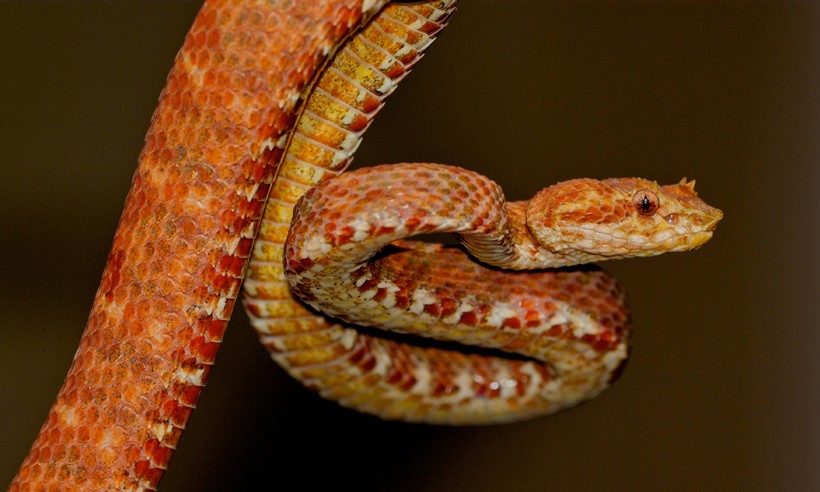
Beautiful red-golden viper, one of the wide variety of color combinations.
?
Image credits: Pedro Bernardo/Shutterstock
While approaching the female, the male eyelash viper sways its head slowly and moves closer. Once he gets in position with both male and female cloacae touching each other, the male passes his sperm into the female using one of his hemipenes.
The gestation period for the female is up to 6 months. Eyelash vipers are ovoviviparous, which means that the eggs hatch inside the female’s body after gestation period and the female give birth to living young ones. After the 6 month gestation period, the eggs hatch inside the female’s body and the living young ones develop further inside their mother’s body for up to 3-4 months more, before finally emerging out. Once the female gives birth she is ready to mate again and reproduce.
During the period of gestation, the mother gains mass and gets slower, leaving her highly vulnerable to predation. Once the young ones emerge, the mother heads to hunt, leaving the young ones on their own.
Baby eyelash vipers are only 15-20 centimetres (5.9 - 7.9”) in length, but they come fully loaded and developed. The young ones can bite and inject venom just like an adult. They can also hunt for themselves and they prey mainly on small frogs and insects in the initial stages of their life.
Just like most snakes, no parental involvement is practised among eyelash vipers. The young ones are left to their own from day one.
A female gives birth to up to 10- 20 young eyelash vipers at a time. However, only a few make it to their adulthood due to the unforgiving nature of tropical rainforests. Small in size, the young are highly vulnerable to predation and starvation. Small mammals, badgers, hedgehogs, birds, even some large spiders and other insects prey on baby eyelash vipers.
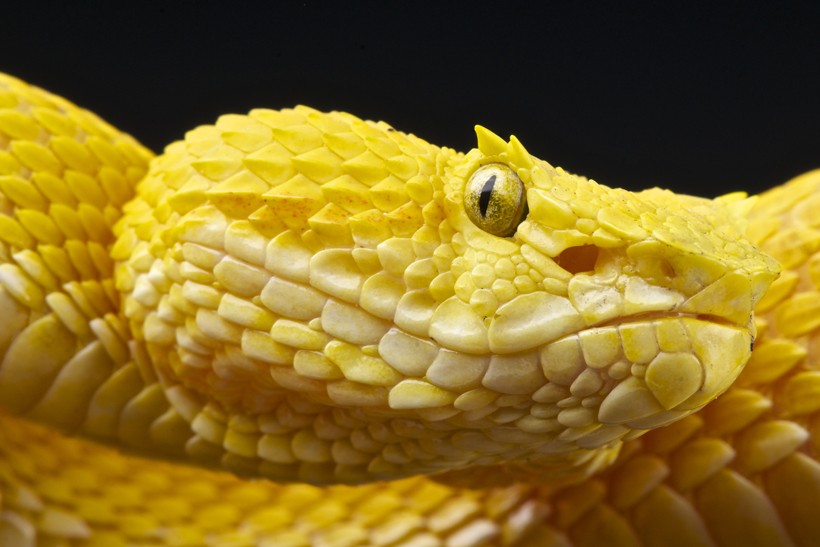
The yellow colored eyelash viper is also known as ‘Oropel’ amongst locals, which means very bright or flashy.
?
Image credits: reptiles4all/Shutterstock
Behavior
Like most snakes, the eyelash viper prefers to stay solitary. It spends most of its day waiting at an ambush site for prey. It is an arboreal snake and likes to stay in dense vegetation, usually a few feet above the ground. So perfect is its ambush technique that early scientist failed to see the other side of this beautiful snake.
The Eyelash viper is nocturnal and is more active at the night. Unlike its daytime nature, this viper doesn’t like to wait and ambush when it’s dark. It can be seen actively hunting small mammals and raiding bird nests under the cover of the night. Some biologists suggest that the primary reason behind its daytime behavior of ambush and camouflage is not just to hunt efficiently, but is actually to protect itself from being spotted by predators. At night, its acute vision gives the eyelash viper an upper hand against prey and predator alike.
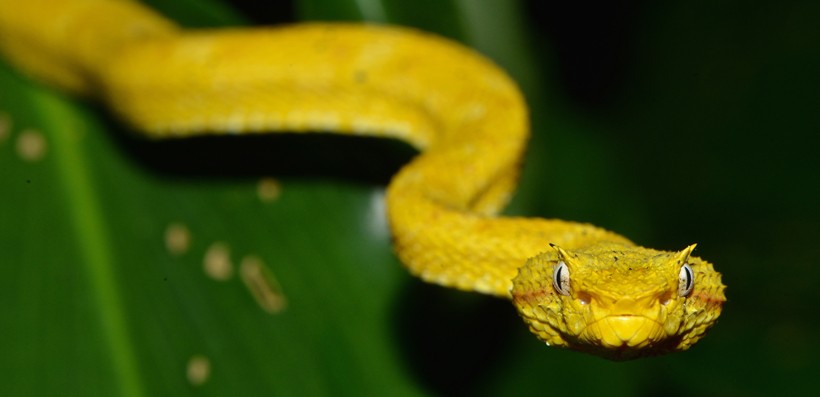
Viper ready to attack
?
Image credits: G.J. Verspui/Shutterstock
A threatened eyelash viper is highly aggressive and ready to attack in a split second. When it sees a potential threat, the snake coils itself in a defensive manner with its mouth on top and wide open. It opens its mouth to give a fair warning to its threat and when that doesn’t work, it doesn’t hesitate before giving a lethal blow to the unwelcome guest. It has one of the fastest strikes in the animal world and bears potent hemotoxic venom containing pro-coagulants and haemorrhagins. The venom quickly starts arresting its victim’s central nervous system and cardiovascular systems. In no time, the enemy is immobilised; if prey, it is swollen whole and if a predator, the eyelash viper simply moves away to safety.
Due to its solitary behavior, not much is known about its methods of communication with other snakes. However, the eyelash viper snake proves to be very intelligent and adaptive. It is capable of learning from its surroundings to improvise its attack and defence strategies.
They repeatedly visit their favourite ambush sites to check for a quick meal. Biologists also suspect that the animal has good knowledge about bird migrations. Eyelash vipers have been repeatedly spotted at ambush sites, where migratory birds arrive.
This species of pit viper have been excluded from CITES Appendix III list of threatened species in 2002. Spread widely across the rain forests of Mexico, Central America and Northern South America, the population of eyelash viper (Bothriechis schlegelii) is considered to be quite stable. However, it faces a sheer threat of habitat loss due to deforestation and urbanisation. Additionally, climatic changes cause lack of dense vegetation in the rainforests, making the viper more vulnerable to predators.
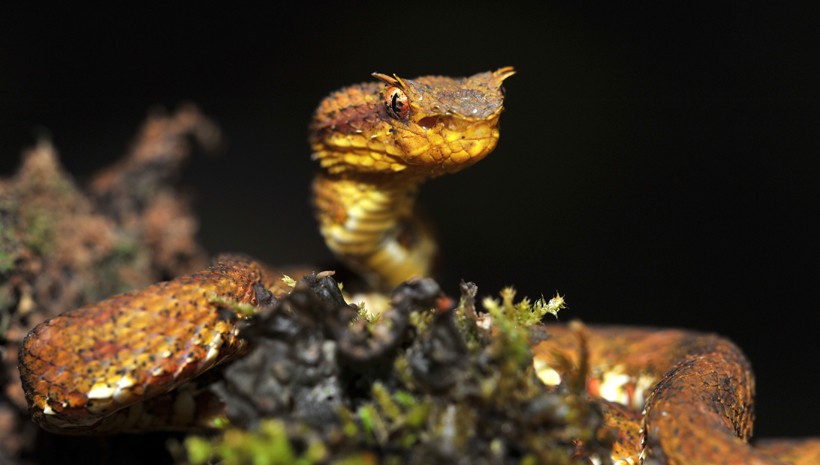
The population is considered stable but it still faces a threat due to deforestation
?
Image credits: worldswildlifewonders/Shutterstock
Evolution
Arnold Berthold, a German zoologist was the first to describe the eyelash pit viper in 1846. Bothriechis Schlegelii falls under the family of pit vipers, also known as Viperidae. Its genus Bothriechis consists of palm pit vipers. All species in this genus are arboreal and can grow up to 60-80 centimetres or 20-28 inches in length. Their venom is hemotoxic and shares similar characteristics like well-defined canthus rostralis, rostral scale, prehensile tail and an unelevated snout.
Not much is known about the fossil history of snakes due to lack of fossil specimens. The skeletal structure of the snakes is very delicate and doesn’t fossilise easily. In part of the South American rain forests, there is a myth that the eyelash viper will wink at its victim and then attack to kill it.
Note
Eyelash vipers are sold as pets in many states and countries due to their beauty. Although it is legal to own one, an eyelash viper is a wild predator that strikes within a blink of your eye. Always remember that these are highly experienced hunters, equipped with lethal venom in their fangs. Their today’s form is a result of millions of years of evolution and survival. Practically, they are the best at what they do. Respect this fact and handle these snakes with immense care and expert guidance. If you have it as a pet, take proper care that the enclosure is sealed well and kept away from children. However, the easiest way to handle the beautiful eyelash vipers is to set them free in their natural habitat and admire their natural ways of surviving in an unforgiving atmosphere.
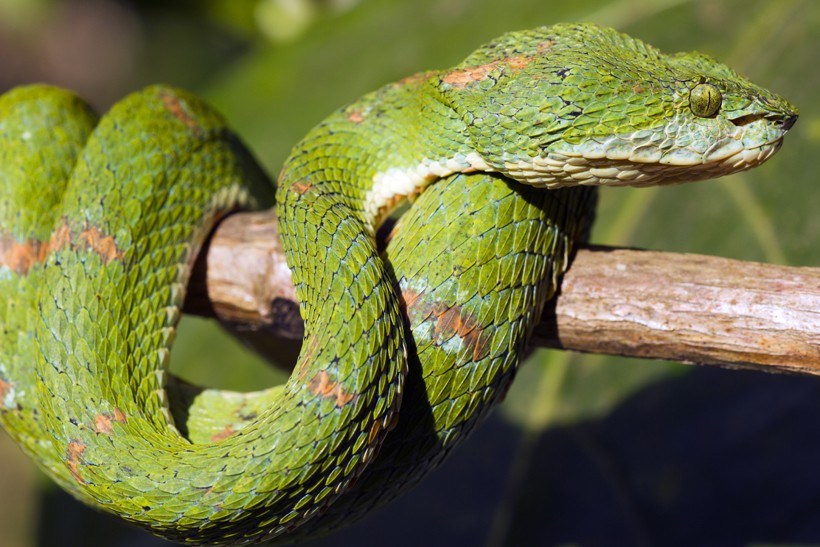
Beautiful, but deadly green eyelash viper on a branch
?
Image credits: Dr. Morley Read/Shutterstock
Funfacts
- Eyelash vipers exist in a very wide variety of color combinations. They can be seen in green, yellow, reddish brown, golden and many more color combinations.
- Commonly found bright yellow colored eyelash viper is also known as ‘Oropel’ amongst locals. ‘Oropel’ means very bright or flashy, in the local language.
- Yellow eyelash viper is so well-camouflaged in bananas, that they have been accidentally transported several times to different countries while exporting bananas.
- The venomous eyelash viper is popular as a pet reptile in many countries.
- Their eyes have vertical pupils and their scales are very rough.
- Although they are arboreal, young eyelash vipers spend a lot of time on the ground as compared to adults.
- No one knows why they stick to rules and don’t bite each other for the female while performing the famous “dance of adders”.
- They have an extremely sensitive fleece between their eye and nostril. With 1000 nerve endings per square millimeter they can notice a change in temperature of 0,026 degrees Celsius!
